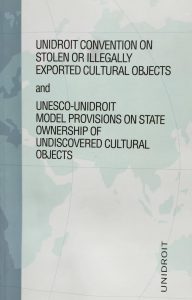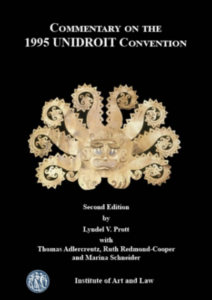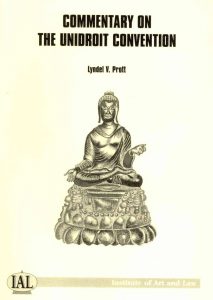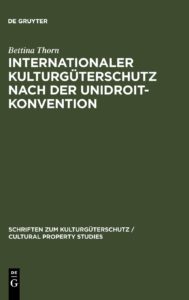UNIDROIT Convention on Stolen or Illegally Exported Cultural Objects: Explanatory Report
prepared by Marina Schneider, UNIDROIT Senior Legal Officer and Treaty Depositary
 |
This report scrutinises the individual clauses of the Convention, their raison d’être, how they took shape in the drafting — where this is relevant to understanding them — and how they may be applied. In this, the report may be of assistance to those States that are considering whether to ratify the Convention or to accede to it. (Arabic, French) |
Commentary on the UNIDROIT Convention [Second Edition]
by Lyndel V. Prott
Published in 2021, 160 Pages. ISBN: 978-1-903978-43-8
 |
This second edition of Lyndel Prott’s Commentary on the 1995 UNIDROIT Convention on Stolen or Illegally Exported Cultural Objects provides not only an article-by-article analysis of the Convention, but also takes account of the many positive developments in the practices of museums and States regarding re-evaluation of the status of objects in collections and, in some cases, return of those objects to their countries of origin. The Convention’s influence can be seen in the text of the 2014 EU Directive on the return of cultural objects unlawfully removed from the territory of a Member State, which, in its introductory paragraphs, calls on Member States of the European Union to consider ratification of both the 1970 UNESCO Convention and the 1995 UNIDROIT Convention. |
Commentary on the UNIDROIT Convention
by Lyndel V. Prott
Published in 1997, 145 Pages. ISBN: 0-9531696-0-X
 |
The UNIDROIT Convention is now in force in several countries, and other States are actively considering ratification. If you deal with a country where the Convention applies, do you fully understand what UNIDROIT means for you? Which transactions are caught? What are the time limits? This article by article Commentary, written by an expert with decades of experience with the problems of illicit traffic in cultural objects, answers these questions and responds to criticisms which have been made of the Convention. |
Internationaler Kulturgüterschutz nach der UNIDROIT-Konvention
by Bettina Thorn
Published by De Gruyter Verlag, Berlin 2005
 |
This work presents the possibility of legal protection of cultural assets using the UNIDROIT Convention on stolen or illegally exported cultural objects of 24.06.1995. The passing of this Convention was a milestone on the route to solving the problems of illegal trade in cultural assets. The work is divided into three main areas. First of all there is an overview of the legal framework of cultural asset protection from international treaties and European legal acts. This is followed by an individual analysis of the regulations of the UNIDROIT Convention and then by a comparison of the convention and national legal regulations in selected European countries. |
Report on the UNIDROIT Convention on Stolen or Illegally Exported Cultural Objects
prepared by The Law Reform Commission of the Republic of Ireland
International trafficking in cultural property is an increasingly universal problem, affecting, to various extents, even countries traditionally seen as “importing” countries and necessitating international regulations (binding and non-binding). Consequently, UNESCO recommends its Member States to consider for ratification, possibly at the same time, both the UNESCO (1970) and UNIDROIT (1995) Conventions.
- Marina Schneider, The 1995 UNIDROIT Convention: an indispensable complement to the 1970 UNESCO Convention and an inspiration for the 2014/60/EU Directive, Santander Art and Culture Law Review, 2016
- Marina Schneider, Protection and Return of Cultural Objects: The Interplay of Law and Ethics, La Diplomazia Culturale, 2013
Prof. Lyndel Prott
- Lyndel V. Prott, UNESCO and UNIDROIT: a Partnership against Trafficking in Cultural Objects, Uniform Law Review/ Revue de droit uniforme, 1996
- Lyndel V. Prott, The UNIDROIT Convention on Stolen or Illegally Exported Cultural Objects – Ten Years On, Uniform Law Review/Revue de droit uniforme, 2009
Prof. Pierre Lalive d’Epinay
